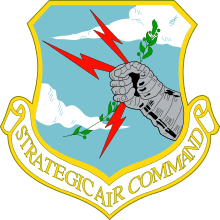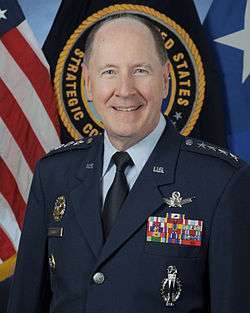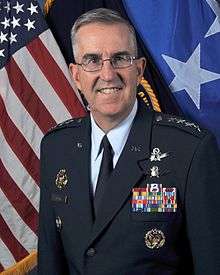United States Strategic Command
| United States Strategic Command | |
|---|---|
|
The official seal of the United States Strategic Command. | |
| Active | 1 June 1992 to present |
| Country |
|
| Type | Functional Combatant Command |
| Role | Strategic deterrence, global strike, strategic warning, integrated missile defense, global C4ISR |
| Part of |
|
| Headquarters | Offutt Air Force Base, Nebraska, U.S. |
| Nickname(s) | STRATCOM, USSTRATCOM |
| Motto(s) | Peace is our Profession |
| Commanders | |
| Current commander | General John E. Hyten, USAF |
United States Strategic Command (USSTRATCOM), is one of nine unified commands in the United States Department of Defense. Headquartered at Offutt Air Force Base, Nebraska, USSTRATCOM is responsible for strategic deterrence, global strike, and operating the Defense Department's Global Information Grid. It also provides a host of capabilities to support the other combatant commands, including strategic warning; integrated missile defense; and global command, control, communications, computers, intelligence, surveillance, and reconnaissance (C4ISR).This dynamic command gives national leadership a unified resource for greater understanding of specific threats around the world and the means to respond to those threats rapidly.[1][2]
Mission statement
USSTRATCOM employs tailored nuclear, cyber, space, global strike, joint electronic warfare, missile defense, and intelligence capabilities to deter aggression, decisively respond if deterrence fails, assure allies, shape adversary behavior, defeat terror, and define the force of the future.[3]
Priorities
- Strategic Deterrence
- Decisive Response
- A Combat-Ready Force[4]
Commander's Intent
- Embrace strategic deterrence, consisting of innovative joint fighting forces integrated and synchronized in multiple domains to ensure national security.
- Ensure that we can and will provide a decisive response to aggression, against any threat, when called upon by national leadership.
- Anticipate and meet tactical, theater, and strategic demands through our campaign plan, our operational plans, and capability development.
- Develop the next generation of professionals and capabilities in order to prevail in future conflicts.[5]
Headquarters Organizational Structure
- J1 - Manpower & Personnel: Develops and administers command manpower and personnel policies, human resources, and personnel assignment programs.[6]

- J2 - Intelligence: Responsible for delivering all-source intelligence while enabling the execution of assigned strategic deterrence, space and cyberspace operations. Directs all intelligence-related support for the Commander and ensures unity of intelligence effort across the Command.[7]
- J3 - Global Operations: Coordinates the planning, employment and operation of DoD strategic assets and combines all current operations, intelligence, and global command and control operations. Subdivisions within J3 include Combat and Information Operations, Current Operations, Logistics, and Joint Electromagnetic Spectrum Operations (JEMSO).[8]
_transits_the_Atlantic_Intracoastal_Waterway_as_it_returns_to_Naval_Submarine_Base_Kings_Bay%2C_Ga._from_a_patrol_mission.jpg)
- J4 - Logistics: The Logistics Directorate plans, coordinates and executes joint logistics functions, and provides capability-based readiness assessments and facilities management in support of U.S. Strategic Command's global mission.[9]
- J5 - Plans and Policy: Responsible for coordinating the development and implementation of national security policy as it applies to the command and the execution of its mission. Develops future plans, policy and strategy across all mission areas as outlined in the Unified Command Plan.[10]

- J6 - C4 Systems: Coordinates, facilitates, monitors and assesses systems, networks and communications requirements.[11]
- J7 - Joint Exercises, Training and Assessments: Manages the USSTRATCOM Commander's Joint Exercises, Training, and Assessments programs in order to ensure readiness to perform the Command missions. Provides modeling and simulation support for exercises and training events to the Joint Chiefs of Staff (JCS), Combatant Commands, and other Major Commands (MAJCOM). Manages the Joint Lessons Learned Program. Augments the battle staff during a crisis.[12]
- J8 - Capability and Resource Integration: Conducts force management and analysis to include integrating, coordinating, prioritizing, and advocating USSTRATCOM future concepts, mission capability needs, weapons system development, support for emerging technologies, and command and control architecture across the mission areas. Responsible for all command requirement processes, and ensures appropriate decision support tools and assessment processes are in place to enhance operational capabilities.[13]
- J10 - Joint Reserve Directorate: The Joint Reserve Directorate advises CDRUSSTRATCOM and staff on matters related to the Army, Air Force, Navy, and Marine Corps Reserve personnel assigned to USSTRATCOM. The J10 coordinates Reserve funding requests with the applicable service.[14]
Component Structure
U.S. Strategic Command's day-to-day planning and execution for the primary mission areas is done by a sub-unified command (USCYBERCOM) and the following USSTRATCOM components:
- U.S. Cyber Command, Ft. Meade, MD – USCYBERCOM plans, coordinates, integrates, synchronizes, and conducts activities to: direct the operations and defense of specified Department of Defense information networks and; prepare to, and when directed, conduct full-spectrum military cyberspace operations in order to enable actions in all domains, ensure US/Allied freedom of action in cyberspace and deny the same to our adversaries.[15]
- JFCC - Global Strike (JFCC-GS), Offutt AFB, NE – Conducts kinetic (nuclear and conventional) and non-kinetic effects planning. GS manages global force activities to assure allies and to deter and dissuade actions detrimental to the United States and its global interests; should deterrence fail, employs global strike forces in support of combatant commander.[16]
- JFCC - Space (JFCC Space), Vandenberg AFB, CA – Continuously coordinates, plans, integrates, commands and controls space operations to provide tailored, responsive, local and global effects, and on order, denies the enemy the same, in support of national, USSTRATCOM, and combatant commander objectives.[17]
- JFCC - Integrated Missile Defense (JFCC-IMD) Schriever AFB, CO – Synchronizes operational-level global missile defense planning, operations support, and the development of missile defense effects for DoD. When directed, also provides alternate missile defense execution support.[18]
- JFCC - Intelligence, Surveillance and Reconnaissance (JFCC-ISR) Bolling AFB, Washington, D.C. – Identifies and recommends appropriate resources to meet high priority intelligence requirements. Essentially, ISR helps ensure the best use of resources to provide decision makers and troops with crucial information when and where they need.[19]
- Joint Warfare Analysis Center (JWAC) Dahlgren, VA – The Joint Warfare Analysis Center (JWAC) provides combatant commands, Joint Staff, and other customers with precise technical solutions in order to carry out the national security and military strategies of the United States. JWAC maintains and enhances its ability to conduct comprehensive technical analysis.[20]
Service components
Army
- Army Space and Missile Defense Command/Army Forces Strategic Command (SMDC/ARSTRAT)
- Army Cyber Command (ARCYBER) (supporting USCYBERCOM)
Marines
- Marine Corps Forces Strategic Command Helps to coordinate USMC and StratCom in areas such as "space, cyberspace, electronic warfare, and combating weapons of mass destruction".[21]
Navy
- Fleet Forces Command (FLTFORCOM)[22]
Air Force
- Air Force Global Strike Command (AFGSC)
- Air Force Space Command (AFSPC)
Command Posts
Global Operations Center
The Global Operations Center, or GOC, is the nerve center for USSTRATCOM. The GOC is responsible for the global situational awareness of the Commander, USSTRATCOM, and is the mechanism by which he exercises operational command and control of the Nation's global strategic forces.[23]

Airborne Command Post

U.S. Strategic Command's Airborne Command Post (ABNCP), also called "Looking Glass", allows USSTRATCOM the ability to command, control, and communicate with its nuclear forces should ground-based command centers become inoperable.[24]
History
U.S. Strategic Command is one of nine unified commands under the Department of Defense (DoD). Headquartered at Offutt Air Force Base, Nebraska, USSTRATCOM is responsible for strategic deterrence, global strike, and operating the Defense Department's Global Information Grid. It also provides a host of capabilities to support the other combatant commands, including strategic warning; integrated missile defense; and global command, control, communications, computers, intelligence, surveillance, and reconnaissance (C4ISR).[25]
Established Oct. 1, 2002, USSTRATCOM has made many contributions to the national defense. For example, it has provided intelligence, planning and cyber support to coalition forces in Afghanistan and Iraq. It monitors orbiting satellites and space debris, allowing high-value spacecraft like the International Space Station to maneuver and avoid collision. It has fielded systems to provide limited protection against ballistic missile attack. In February 2008, it destroyed a satellite that was about to re-enter the earth's atmosphere. In 2011, it supported U.S. Africa Command's operations against Libya in a variety of ways, including long-range conventional strikes and ISR. Today's USSTRATCOM is the product of an evolution from a nuclear command to a strategic one in the broadest sense-from an organization prepared to employ thermonuclear weapons in a general war (which it existed to prevent) to a command that creates a variety of global strategic effects day to day in support of national objectives. Its rich history draws on important contributions from many different organizations stretching back to World War II.[26]
The missions most directly associated with USSTRATCOM and its predecessors are deterrence and global strike. These were the missions of Strategic Air Command (SAC) from 1946 to 1992 and of the first USSTRATCOM from 1992 to 2002. SAC was created in March 1946 as one of three major commands of the U.S. Army Air Forces and became a major command of the U.S. Air Force in September 1947. As a specified combatant command, it was also charged with conducting long-range strike operations under the direction of the Joint Chiefs of Staff. SAC's second commander, Gen. Curtis E. LeMay, built it into a combat-ready force with a peak strength in the late 1950s and early 1960s of 3,200 aircraft and 280,000 people. In the 1960s, aircraft strength dropped, offset by a force of 1,054 intercontinental ballistic missiles. To deter attack, the command kept these missiles and a sizable proportion of its bombers and tankers on alert, ready to launch within minutes. To assure command and control, in February 1961 EC-135, "Looking Glass" airborne command posts began round-the-clock flight operations that continued until July 1990. (Navy E-6B Mercury aircraft replaced the EC-135s in 1998 and have performed a random mix of air and ground alert to this day.)[27][28]

After the U.S. Navy began deploying "Polaris" ballistic missile submarines in the late 1950s, Navy and Air Force leaders agreed to create a Joint Strategic Target Planning Staff (JSTPS) that planned how all US nuclear forces would be used in wartime. JSTPS produced its first Single Integrated Operational Plan in 1961.[29]
Though best known for its connection with the nuclear deterrent, SAC conducted conventional bombing operations during the Korean war, 1950–53; the Vietnam War, 1964-73; and the first Persian Gulf War, 1991. Meanwhile, SAC's reconnaissance aircraft monitored developments along the periphery of the communist world and at various hot spots and flash points.[30]
On June 1, 1992, SAC and the JSTPS were replaced by a new unified command, USSTRATCOM. In addition to the dramatic changes in the global landscape associated with the end of the Cold War, changes in the structure of the DoD stemming from the 1986 "Goldwater-Nichols Act" led national leaders to favor a single command responsible for all strategic nuclear forces. The new command's principal mission was to deter military attack, especially nuclear attack, on the United States and its allies and, if deterrence failed, to employ nuclear forces.[31]
As USSTRATCOM neared its tenth anniversary, Secretary of Defense Donald Rumsfeld revived an idea that had been considered several times before, a merger of U.S. Space Command and USSTRATCOM. America's military had begun operating in space in the late 1950s, with many of the early systems developed to meet SAC's needs for surveillance, warning, meteorology, and communications. By September 1985, space activities had grown to the point that the Pentagon created a new unified command, USSPACECOM, to oversee them. Space systems gave the coalition in Operation Desert Storm a decisive edge, while later operations in the Balkans, Southwest Asia, Afghanistan and Iraq relied heavily on space-based command and control, communications, surveillance and intelligence, navigation, and weather systems. Secretary Rumsfeld's initiative to merge the two commands led to the creation of the current USSTRATCOM in 2002.[32]
Two other missions took on increasing importance in the new century: missile defense and operations in cyberspace. Work on missile defenses began in the late 1940s. By the mid-1970s, the U.S. had begun to deploy a "Safeguard" system, only to have Congress cancel it soon after it was operational. President Ronald Reagan renewed efforts in 1983 with his Strategic Defense Initiative, which sought to defend the U.S. from large-scale attacks by the Soviet Union. The end of the Cold War caused a reorientation of the program; the new emphasis was on theater defenses and protection against small strikes. By September 2004, the U.S. had deployed a limited, layered system that offered some protection to North America and had opened discussions about extending the system to cover allies.[33]
The U.S. military's reliance on computer networks grew exponentially in the 1980s and 1990s. National leaders took steps to protect defense networks in 1998, creating a Joint Task Force for Computer Network Defense and assigning it to USSPACECOM. In April 2001, the task force's mission expanded to include computer network attack, and it was renamed Joint Task Force-Computer Network Operations. The task force became part of USSTRATCOM in October 2002; it was renamed Joint Task Force-Global Network Operations (JTF-GNO) in 2004. The network attack mission transferred in 2003 to a new organization, which evolved into the Joint Functional Component Command-Network Warfare (JFCC-NW) in January 2005.[34]
A new attack led to further reorganization. A malicious code, which would allow an adversary to download critical defense information, spread across the DoD's classified and unclassified networks in 2008. As JTF-GNO synchronized efforts to disinfect and protect over 2.5 million computers in 3,500 DoD organizations spanning 99 countries, Defense Secretary Robert Gates endorsed the idea of a new sub-unified command under USSTRATCOM that would recombine offensive and defensive computer network operations. Established 21 May 2010, U.S. Cyber Command was fully operational on Oct. 31, 2010. JTF-GNO and JFCC-NW were disestablished.[35]
Today, USSTRATCOM supports operations worldwide, sharing its broad portfolio of capabilities with the other combatant commands, while maintaining the readiness of the nation's nuclear deterrent.[36]
| No. | Image | Name | Start of Term | End of Term |
|---|---|---|---|---|
| 1. |  |
General George L. Butler, USAF | 1992 | 1994 |
| 2. |  |
Admiral Henry G. Chiles, Jr., USN | 1994 | 1996 |
| 3. |  |
General Eugene E. Habiger, USAF | 1996 | 1998 |
| 4. |  |
Admiral Richard W. Mies, USN | 1998 | 2002 |
| 5. |  |
Admiral James O. Ellis, Jr., USN | 2002 | 2004 |
| 6. |  |
General James E. Cartwright, USMC | 2004 | 2007 |
| Acting |  |
Lt. Gen C. Robert Kehler, USAF | 4 August 2007 | 17 October 2007 |
| 7. |  |
General Kevin P. Chilton, USAF | 2007 | 2011 |
| 8. |  |
General C. Robert Kehler, USAF | 2011 | 2013 |
| 9. |  |
Admiral Cecil D. Haney, USN | 2013 | 2016 |
| 10. |  |
General John E. Hyten, USAF | 2016 | Present |
See also
- Nuclear weapons and the United States
- LGM-30 Minuteman ICBM
- Ohio-class submarine
- B-2 Spirit
- B-52 Stratofortress
- E-6B Mercury
- Strategic Air Command
References
- ↑ USSTRATCOM About
- ↑ USSTRATCOM History
- ↑ USSTRATCOM Snapshot
- ↑ USSTRATCOM Snapshot
- ↑ USSTRATCOM Snapshot
- ↑ USSTRATCOM Snapshot
- ↑ USSTRATCOM Snapshot
- ↑ USSTRATCOM Snapshot
- ↑ USSTRATCOM Snapshot
- ↑ USSTRATCOM Snapshot
- ↑ USSTRATCOM Snapshot
- ↑ USSTRATCOM Snapshot
- ↑ USSTRATCOM Snapshot
- ↑ USSTRATCOM Snapshot
- ↑ USSTRATCOM Snapshot
- ↑ USSTRATCOM Snapshot
- ↑ USSTRATCOM Snapshot
- ↑ USSTRATCOM Snapshot
- ↑ USSTRATCOM Snapshot
- ↑ USSTRATCOM Snapshot
- ↑ "MARFORSTRAT - Headquarters."
- ↑ U.S. Strategic Command Service Components
- ↑ USSTRATCOM About
- ↑ USSTRATCOM ABNCP Fact Sheet
- ↑ USSTRATCOM History
- ↑ USSTRATCOM History
- ↑ USSTRATCOM History
- ↑ USSTRATCOM ABNCP Fact Sheet
- ↑ USSTRATCOM History
- ↑ USSTRATCOM History
- ↑ USSTRATCOM History
- ↑ USSTRATCOM History
- ↑ USSTRATCOM History
- ↑ USSTRATCOM History
- ↑ USSTRATCOM History
- ↑ USSTRATCOM History
External links
| Wikimedia Commons has media related to United States Strategic Command. |
- The Unified Command Plan, Joint Forces Quarterly; Johnson, Spencer (September 2002).
- United States Strategic Command Official Website
- US Strategic Command Airborne Command Post Fact Sheet
- Air Force Magazine, Journal of the Air Force Assoc., August 2008.
- FAS: United States Space Command (USSPACECOM)
- GAO Report: Additional Actions Needed by U.S. Strategic Command to Strengthen Implementation of Its Many Missions and New Organization

